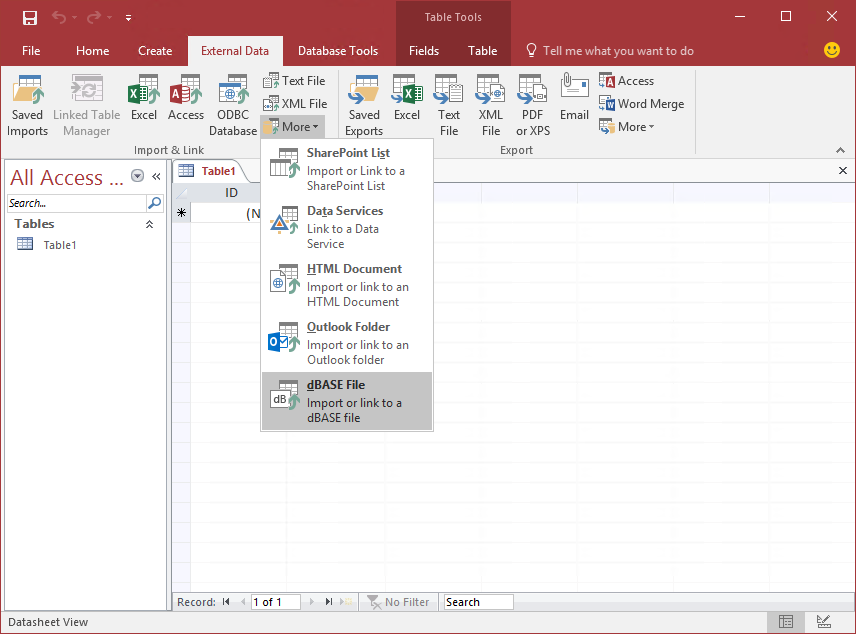To convert your database using RebaseData, run the following command: java -jar client-0.0.5.jar convert -output-format=xlsx file.dbf output-dir/. Replace file.dbf with the path to the database you want to convert. The file output.zip will contain a Excel file, one for each table in the set of input files.
for FREE
When you have data for several years saved as Excel documents, transferring all the records to a DBF file is a pain. First of all, automatic exporting that Excel offers is far from ideal. And Excel 2013 cannot save dBase III and IV file format at all, it only reads them. Second, the complex structure of data often does not fit into the structure of a DBF file without manual adjustment. Third, the performance is not what you’d expect from a software giant.
Importing.DBF files into Excel 2007 I have an XYZ.DBF file that I've imported into Excel 2007 but it doesn't parse properly on the import. The entire record goes into Column A of the Excel 2007 worksheet, Sheet 1. Columns B and up don't have anything in them. I think a record key is in the first several characters of each record. To import several dbf files you should use the Import/Export Wizard. Click Import and Export Data menu item from the Start menu. First, open the.DBF file using the standard File - Open. Microsoft Access File Open Menu. Open the DBF file directly Using the Open Dialog. Open the DBF File Directly. You’ll have to make sure that you choose one of the dBASE formats so that the.dbf files show up in your list to choose from. I have chosen dBASE III (.dbf) in this example. Convert xls to dbf. Import from XLS / XLSX (Excel) to DBF Base. This dialog window imports data from an Excel file. With 'Import data into current (opened) database file' option, the DBFView will insert records from xls / xlsx file you selected into current dbf file.
The solution? Try DBF Viewer 2000 to import data from Excel to DBF. The tool works faster, reads any XLS and XLSX documents and promptly imports information from them to the selected DBF file.
Once you open the Excel file you want to import records from in DBF Viewer 2000, it scans the file and presents you a quick preview of all sheets in the document. The program detects field types and lengths automatically.
In fact, the process is automated almost completely, so there’re no many options left. The “First row” option allows you to tell the program where the actual data start. This is handy, when the XLS document has a complex header.
And the “Remove all records” option allows you to remove old records from file.
Once, you are done, click OK and the data are imported to DBF.
Excel to DBF importing via command line

'c:Program Files (x86)DBF Viewer 2000dbview.exe' /APPEND:file1.dbf,file2.xlsx [/ZAP]
Examples:Simple importing
c:Program Files (x86)DBF Viewer 2000dbview.exe /APPEND:file1.dbf,src.xlsx

Importing with removing old records
'c:Program Files (x86)DBF Viewer 2000dbview.exe' /APPEND:file1.dbf,src.xlsx /ZAP
Convert Xls To Dbf
for FREE

Seealso: DBF to CSV, DBF to XML, DBF to SQL, command line options,Filtering records in dbffile
Back to DBF Viewer 2000 HomePage top | Contacts | Copyright © HiBase Group, 2002-2021
Import Dbf File Into Excel
-->You can import Visual FoxPro data into your Microsoft Excel worksheet if you have defined a data source for it. For information about creating a Visual FoxPro data source, see Accessing a Visual FoxPro Data Source from Microsoft Excel.
Import Dbf File To Excel
To import Visual FoxPro data into an Microsoft Excel worksheet
Open a Microsoft Excel spreadsheet.
From the Data menu, choose Get External Data. Microsoft Query opens.
In the Select Data Source dialog box, select a Visual FoxPro data source and then click Use.
If the database accessed by your data source includes tables, select a table from the Add Tables dialog box. Microsoft Query displays the added table in the top half of the query designer.
Note
The Owner list is not available in this dialog box because the driver does not support owners. The Database list is not available because the driver does not support multiple databases in a data source.
Select fields for your query by dragging them from the table onto the lower half of the designer.
Close Microsoft Query. The data you selected is imported into your Microsoft Excel spreadsheet.
